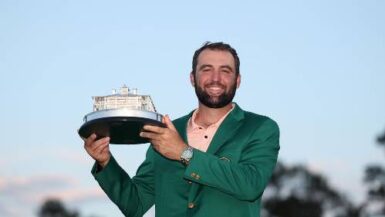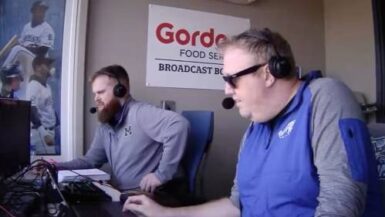
There’s an old adage in sports – so-called “miracles” actually happen with surprising frequency.
This week at Augusta National was a textbook example. Jordan Spieth needs a wheelbarrow to haul away all the important records he broke or tied in the 79th Masters, including lowest opening 36 holes (130), lowest opening 54 holes (200), lowest 72 hole aggregate (270), and lowest score in relation to par (-18). He also tied the all-time major championship record for opening 36 holes. In becoming the first wire-to-wire winner of the Masters in 39 years, he shattered the tournament record for most birdies (28), he played holes 8-13 – a stretch that includes Amen Corner – in a sizzling 13-under par for the week, and he did it all as the second youngest winner in Masters history. There is no way to overstate what he accomplished.
“Have you ever seen anything like this?” asked one broadcaster colleague, breathless with star-struck awe.
“Well…yes, actually,” I dared to say. “I have.”
Balloon, meet pin.
I waited for my colleague to get done harrumphing at my gall, my sheer effrontery at daring to utter such blasphemy at a moment like this. He called me “jaded,” he said I was just a cynic and an iconoclast, he went on so long I actually had to ask him, “Do you want to hear this or do you just want to yell?”
He laughed at that, finally quieted down, and I could explain one of those surprising but indelible truths about sports: Record setting runaways happen a lot, especially in golf.
We saw this same movie twice last year alone. First, Martin Kaymer opened last year’s U.S. Open at Pinehurst with a blistering 65-65, pulverizing supposedly unconquerable Pinehurst into a puny muni, and turning the U.S. Open into the John Deere Classic. Like Spieth, Kaymer went wire-to-wire, and in doing so joined a list of golfing royalty who were solo wire-to-wire winners: Rory McIlroy, Tiger Woods, Tony Jacklin, Ben Hogan, Walter Hagen, and James Barnes. Kaymer took the lead at last year’s Open with a sizzling first round, built a gargantuan lead after 36 holes, survived an iffy ball stroking day on Saturday but still kept the huge lead, then put the tournament in a sleeper hold by the 10th tee and used the final nine holes as a victory lap.
Spieth’s win this week was a carbon copy of Kaymer’s playbook, and the list of Masters wire-to-wire winners he joins is even more phenomenal: Craig Wood, Arnold Palmer, Jack Nicklaus, and Ray Floyd. Spieth’s opening 64 featured an astounding nine birdies and just one bogey – on 15, the easiest hole on the course. His three shot lead swelled to four after a bogey-free 6-under 66 on Friday.
“This tournament was over when he put up the 70 on Saturday,” opined former PGA Championship winner Steve Elkongton, and he was right. No one got within three shots of Spieth for the entire weekend. It looks like the kind of stat you just label as a statistical outlier and toss over your shoulder for the anomaly it is…only things like this keep happening with surprising frequency.
Just one month after Kaymer’s runaway at Pinehurst, Rory McIlroy surgically filleted Royal Liverpool at the Open Championship with a dominating wire-to-wire victory. He took sole possession of the lead with an opening 66. With another 66 on Friday he opened up a four shot lead. It was six by the end of Saturday’s play, and he could afford an indifferent 71 to close. Though he ultimately won by only two shots, that stat is deceiving since it was a plucky finish by Rickie Fowler – three birdies over the last four holes – that made the result that close: the golf equivalent of two garbage-time touchdowns that equate to a back-door cover.
Rory has actually made a cottage industry out of shattering records and dominating majors. At the 2011 U.S. Open he set or tied 11 tournament records, including lowest 36, 54, and 72 hole aggregates, and lowest score-to-par, (-16). He broke 70 all four rounds, and went solo wire-to-wire. Poor Jason Day…his aggregate score would have been good enough to win or get into a playoff at 18 of the previous 20 Opens, and he still lost by eight shots.
Then at Kiawah Island, Rory fired a dazzling 67-66 on the weekend to run away with the 2012 PGA Championship by tournament record eight shots, the same margin of victory he recorded at Congressional. On Saturday he surged into the lead with five birdies in his first eight holes and a par save from the branches of a tree at the par-4 third. On Sunday, McIlroy went bogey-free and took just 24 putts on the day.
“He looked like Tiger again,” said golf expert Bruce Moulton at the time. “He’s winning the same way – in dominant, record-setting fashion. He’s breaking records we said only a few years ago would never be broken.”
Tiger, of course, set scoring records in all four major championships and won all four by gargantuan margins of victory. He said “Hello World” at the ’97 Masters by breaking nearly every major scoring record and demolishing the field by 12 shots. Yet that was a Swedish massage compared to the annihilation, the downright thermonuclear vaporization of mighty Pebble Beach at the 2000 U.S. Open, where broke a barrel-full of scoring records and won by a Brobdingnagian 15 shots.
As an aside, how about that? I used Brobdingnagian in a sentence. And I spelled it correctly too…
Anyway, the 12-under par, 15-shot victory at Pebble Beach in the 2000 U.S. Open was so overwhelming, runner-up Ernie Els quipped, “If he wins the British Open by 15 shots, there ought to be an inquiry.”
Woods won by 8, but he did set the Open Championship scoring record. He followed that with a record setting performance at Valhalla for his third straight major win, and then completed the four-in-a-row “Tiger Slam” at the 2001 Masters.
Even Louis Oosthuizen got into the act recently. His interesting line score of 65-67-69-71 (two shots higher every day) won by seven shots. The second round 67 was the key, as Oosthuizen played in the second group of the day and avoided the ghastly weather that blew on off the firth. The wind howled up to 40 miles per hour and rain streaked sideway cross the sky causing first-round leader Rory McIlroy to go from 63 the first day to 80 the second. Oosthuizen found himself with a five-shot lead going into the weekend, and it never got closer than three as he cruised around the Old Course on the way to both the Claret Jug and the replica Moroccan Belt at the 150th Anniversary Open Championship.
Still, there was much to marvel at during this coming out party for a kid who looks like what Ben Hogan must have looked like back in the ’40s. When Tiger shot 18 under in the 1997 Masters, Augusta was 6,925 yards. Now it’s 7,435. Jordan hit a 280-yard 3-wood (with 265 yards of carry) to the second green on Sunday. 15 years ago, you couldn’t do that with a Howitzer, (unless your name was Tiger Woods).
“No part of me was going to lay up there,” Spieth said laconically. That’s how you win the Masters – you get after the golf course. Unlike the U.S. Open, the Masters doesn’t win you, you have to win the Masters.
You also make sure to keep your ball dry on the back nine, (“Driest ball wins,” as iconic writer Dan Jenkins likes to say), and while Spieth may point to saving par on 16 as the clinching moment, it was his approach on 13 – a shot that was both inches from disaster and perfection at once – that was the defining shot of the 79th Masters.
“I missed the 5 iron a little,” Spieth admitted candidly. “I was trying to go a little left and just kind of hit it a little straight, a little off the toe. I was yelling, you know, “Get up, get up.” When it landed, from my angle, I thought it hit short in the water and all of a sudden the roar came up and the pitchmark was right on that little peninsula, And there was another moment where I thought, this could be destiny.”
“Destiny?” Who knows? “Magic?” Yes, certainly. Jordan had that uncanny ability of great champions to bounce right back after a mistake. The few times he made bogey this week, he’d make a birdie right back. He kept the momentum during the white-hot crucible of Masters pressure.
“It was nerve wracking,” he stated honestly. “I couldn’t sleep well last night. I woke up before seven and I was just wide awake and I had nine hours before I teed off….But it was the most incredible week of my life. As great as it gets in our game.”
And so the cycle continues, the wheel turns round yet again. As Tiger’s star begins to wane, Rory rises to take his place. After Rory and Kaymer reset major records in the last three years, along comes Spieth to rewrite the record books. We saw an historic performance…yet again. But we are seeing them quite frequently, actually. (What a wondrous time to be a golf fan!) And as players get stronger, more skillful, and equipment advances allow them to play shots unthinkable a few years back, we’ll see even more. Remember – when Tiger won al his majors, there weren’t too many other truly great players to challenge him. Phil, Ernie, and Vijay were around, but the rest were one or two-hit wonders like David Duval and Retief Goosen, or flavors of the week like Chris DiMarco, Bob May, Shaun Micheel, Woody, Austin, and Thomas Bjorn. Now you can’t spit without hitting a guy capable of rattling off six or seven majors in a career.
“The game is in great hands. We have so much to look forward to with Spieth and Rory…Fowler and Bubba Watson and Jason Day, that we don’t have to worry about golf without Tiger Woods,” said Nick Faldo. “It’s going to be exciting,” he concluded, and he’s right. The new generation has not only taken root, but has sprouted. With every passing major they grow stronger and, to paraphrase author Emile Zola, soon they will split the golf world asunder with their power. If they’re not doing that already.
{Author’s Note: See everyone live from Winged Foot for the Anderson Memorial and from Chambers Bay for the U.S. Open.]




